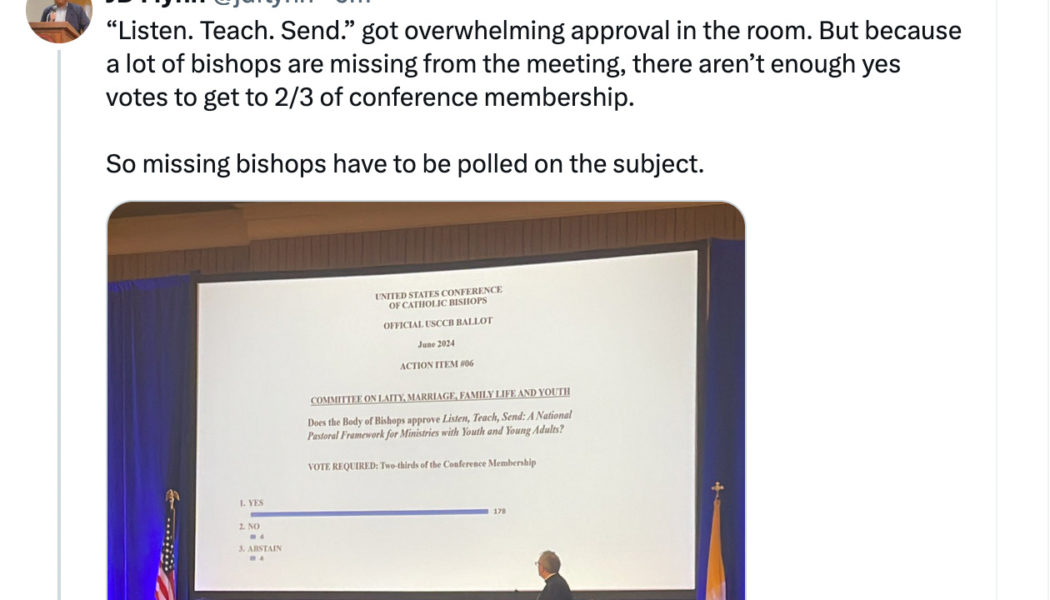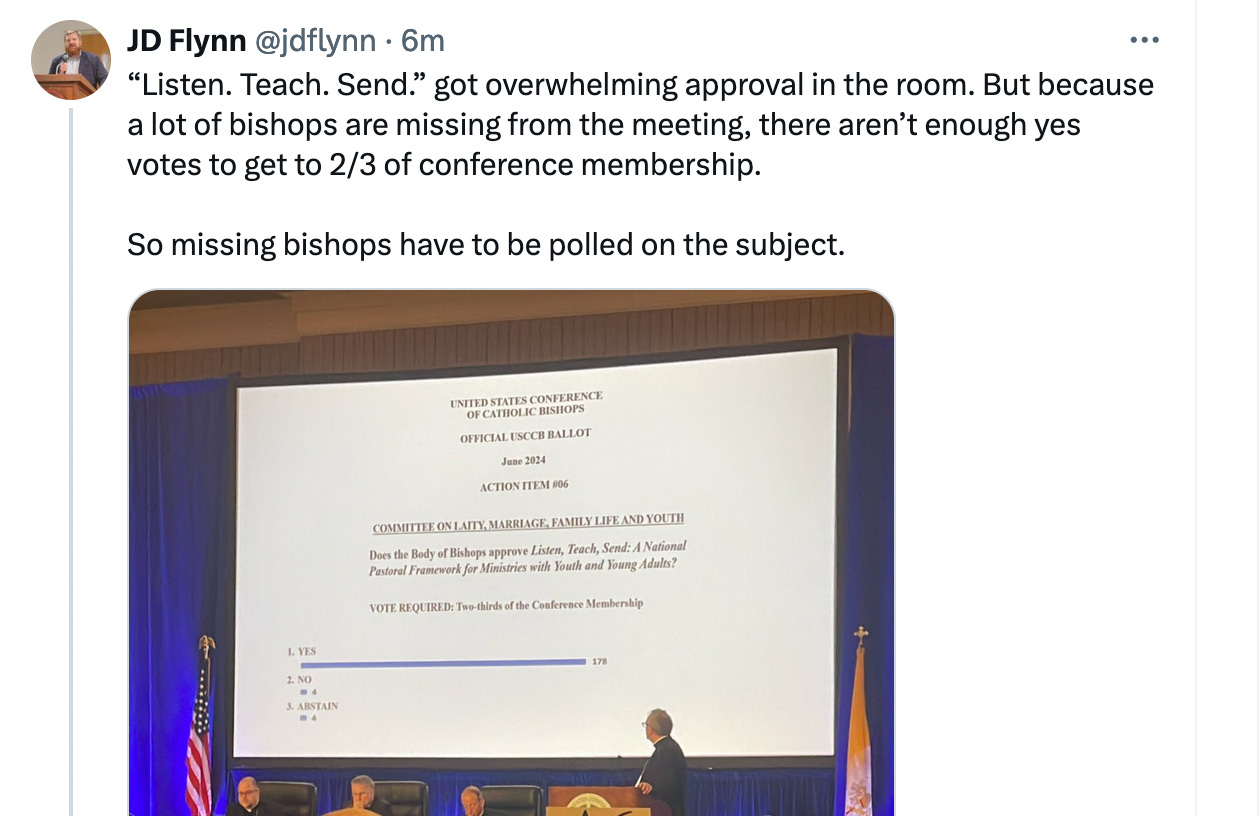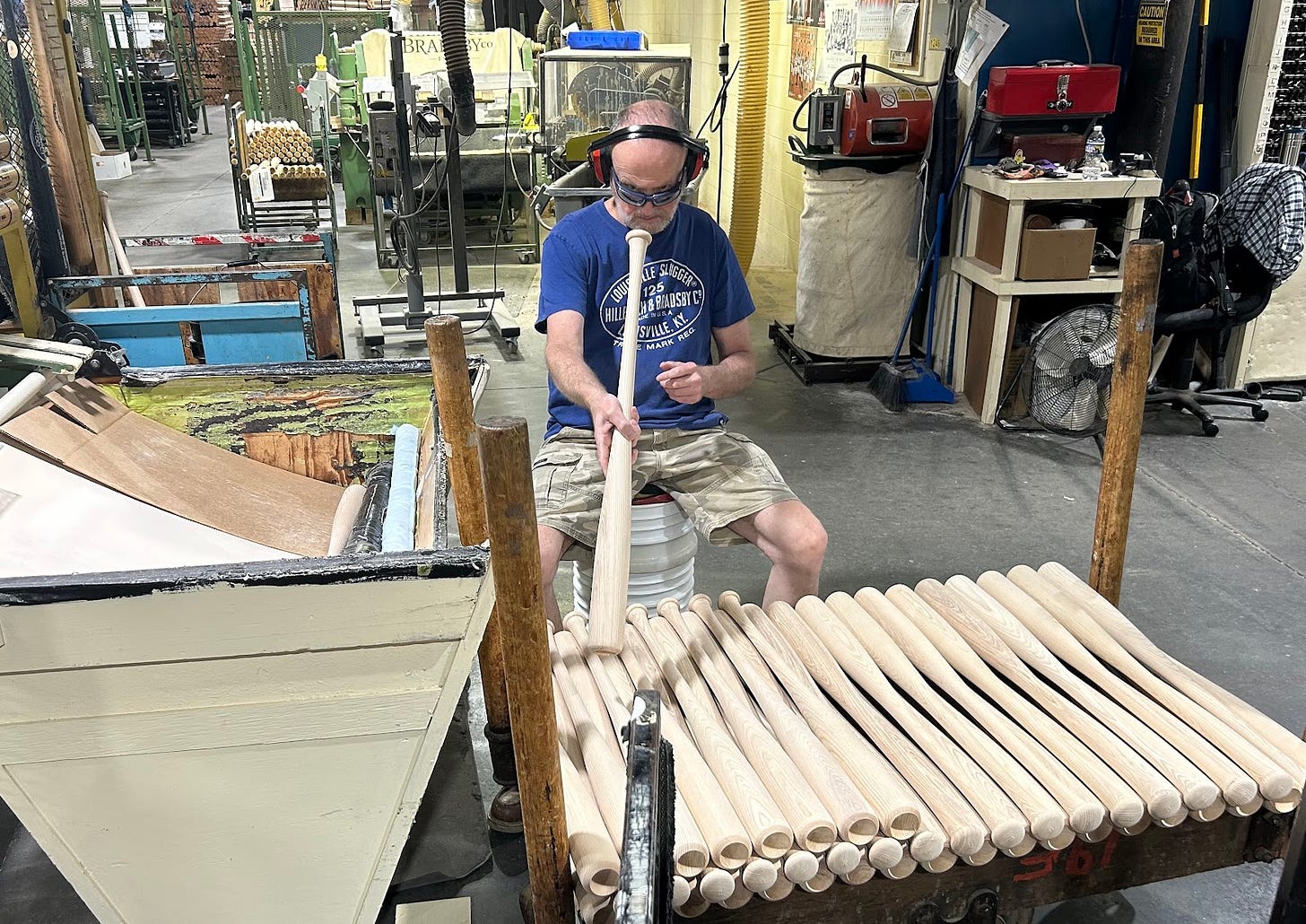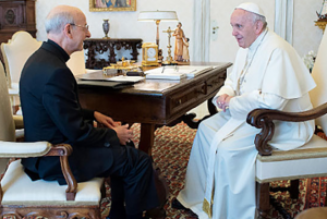Happy Friday friends,
And hello from Louisville. The USCCB spring assembly has been a fairly low-key event, as these things go.
There were some important bits of business done, of course. There always are. And we’ll get to those in a second. But the conference floor was a little empty in comparison to recent meetings.
Several bishops told us in advance of the meeting that they weren’t coming at all — more than a few of them, I think, are saving their energy and days out of the diocese for the Eucharistic Congress in Indianapolis next month.
Actually, numbers are so down that it’s created a bit of a problem in the hall.
When the assembly went to vote to approve “Listen, Teach, Send,” the bishops’ national framework for youth ministries, it turned out that, even with nearly every bishop in the room voting “Aye,” there weren’t enough episcopal warm bodies to reach the necessary two-thirds of the conference membership.
Oops.
They are also missing a good time in Kentucky. I love Louisville. It’s hard not to, given it’s a city pretty self-consciously devoted to bourbon and baseball bats.
Of course, a lot of people think of this place in relation to the horseracing thing but, walking around town, the impression I get is that’s mostly seasonal schtick. The derby stuff notwithstanding, and off the main drag of upscale bourbon bars and micro distilleries, what I like most about this place is it still feels like a city very much living on its own terms.
There are more decent dive bars with live music within three blocks of the conference hotel than in the whole greater Washington area, and none of them seemed to me to be afflicted with the kind of winking hipster irony that blights other post-industrial middle-American cities on the bounce.
I’m looking at you, Philly and Pittsburgh.
Actually, the thing that struck me most about Louisville as I walked around was that it doesn’t feel hollowed out at all, or even particularly like a city reinventing itself. It just feels local and lived-in. Well preserved, I’d call it.
I stuck my head in this place, because the signage was just so attractive, half expecting to find it was just a preserved frontage, behind which lurked a “cold brew” cafe or vape shop.
Imagine my surprise to learn they were still a family-owned and operated business, founded in the middle of the Great Depression and now in fourth-generation hands, making real, actual, honest-to-God elevators right there on Main Street.
As it happens, I haven’t seen a single vape shop since I’ve been here, and if that isn’t a barometer of a civilization enduring I don’t know what is.
Sure, it’s a college sports town, so there are an unreasonable number of hotels downtown, relative to its size. But dotted in between them are distinctly local liquor stores and family businesses — a surprising number of which actually still make stuff.
And the people are unfailingly nice, and unflappably relaxed when out-of-towners ask idiot questions, like “do you make elevators here?”
Anyway, here’s the news.
The News
Several U.S. bishops have requested that the USCCB canonical affairs committee provide guidance and direction on issues raised by the case of a diocesan hermit who publicly identified last month as transgender.
Sources close to the conference told The Pillar that a group of bishops requested that conference president Archbishop Broglio commission the canon law committee to discuss and give direction on transgender identity in religious life ahead of this week’s USCCB plenary assembly in Louisville.
The request was presented after Br. Christian Matson, a diocesan hermit of the Lexington diocese, posted on Facebook last month, saying “I have now completed my period of initial formation and professed public vows of poverty, chastity, and obedience as a diocesan hermit for the Diocese of Lexington, Kentucky.”
“My friends, I would like to share with you that I am a transgender Catholic,” the hermit wrote.
Recent documents from the Vatican and USCCB, including the DDF’s declaration Dignitas infinita earlier this year, have made clear the Church’s rejection of so-called “gender theory” and cosmetic sexual reassignment surgeries.
But Broglio told press Thursday that “concern has been expressed” by some bishops in relation to the Lexington hermit, raising questions “because of the nature of what eremitic life is in the Church, and also the preparation necessary for that.”
—
The public sessions of the bishops’ plenary assembly opened, as they always do, with speeches from the conference president, Archbishop Broglio, and the apostolic nuncio, Cardinal Christophe Pierre.
While Pierre opted to speak around the theme of adoration and the Eucharist, Broglio opted for more of a whirlwind tour of issues.
You can read all about the speeches here.
—
This morning the bishops voted to approve the pastoral framework for Native American Catholic communities.
The text was supposed to be voted on last November but was yanked at the last minute because, as we reported at the time, there were some legal concerns with the language.
The somewhat dry title of the document belies some serious and emotive discussion of the suffering of Native communities over the centuries, and the sometimes painful role the Church has had in that.
Earlier this week I wrote an analysis trying to forecast what language is likely to have been edited out of the November text, and what will still be in.
—
Much of the chatter around the conference has been on the future shape of the Catholic Campaign for Human Development.
CCHD distributes grants that fund community and economic development initiatives, and gets its money from an annual second collection. As we reported earlier this year, its structure and grant-giving are up for review by the bishops this week, because it has fallen badly into the red.
The bishops discussed the campaign, its circumstances, and future during executive session, but conference president Archbishop Broglio told press that there was unanimous appreciation for CCHD’s work and the feedback from the conference’s committee.
Economic realities are what they are for the CCHD, but any big changes to the campaign are likely to come slowly.
Johnny Zokovitch, executive director of Pax Christi USA, which organized the demonstration, told us: “The main reason why CCHD is important is that they help lift up the voices of people who are most directly impacted by things like poverty — helping to both rise up leadership from among those folks who are directly impacted, from vulnerable and marginalized communities.”
Others there offered what I think it’s fair to call more emotional support to the idea of the CCHD, rather than the nuts and bolts of what it does.
“I wasn’t aware of what exactly was on their agenda,” Dotty Lockhart told us, “but I thought I would come out this morning, ‘cause that’s what I do. I’m a retired teacher, so when people say to show up, I do.”
Fair enough.
You can read all about the state of play with CCHD right here.
Away from Louisville, there’s plenty going on in the Church this week.
The Vatican’s Dicastery for Promoting Christian Unity issued a new study document on the Petrine office, papal primacy, and synodality in ecumenical dialogues.
The lengthy text compiles and digests recent ecumenical developments on the theme, especially in the light of Pope St. John Paul II’s 1995 encyclical on ecumenism Ut unum sint.
Weighing in at more than 40,000 words and nearly 150 pages, it’s a lot to get through, but you’d be right to suspect there are some interesting things in there — especially in sections with headings like “Towards an Exercise of Primacy in the 21st century.”
—
A new bill in Australia is seeking to end the years-long “cemetery wars” that have pitted the Catholic Church against local state authorities.
Sydney’s Archbishop Anthony Fisher said at the time that it was “a matter of religious liberty and a matter of respect for the dead.”
“No doubt there are some in government or the bureaucracy who would like to see faith groups vacate this space, as they would like to drive us out of education, healthcare and the like. But we will not give up the care of our dead without a fight,” said the archbishop, and it now looks light the fight has been won.
NSW government minister Stephen Kamper introduced new legislation this week which he said will “bring the cemetery wars to a close,” “acknowledges the Catholic Church’s track record of delivering essential interment services on crown land for over 150 years,” and ensures its role for the future.
Read all about the bill, and the fight for the state’s cemeteries, here.
—
Last weekend, voters across the continent headed to the polls to elect their representatives in the European Parliament and recorded a notable rightward lurch in several countries.
So what are they to do? Well, Edgar spoke to bishops across the continent about the situation in their countries, and what they had to say is well worth your time.
Sacra: Relics of the Saints is an apostolate established to promote the veneration of sacred relics. Sacra works with religious communities, dioceses, and archives to identify, document, authenticate, and repair relics. Does your parish have questions about its relics? Send us a message.
It’s something he said
Pope Francis was back in the international headlines this week when it emerged that he’d again deployed an offensive Italian term which can, I am afraid, only really be translated as “faggotry,” while discussing the discipline not to admit men with homosexual tendencies to seminaries, this time in a meeting with Italian priests.
It’s the second time in recent weeks Pope Francis has reportedly used the word, and reiterated the bar on the admission of men with deep-seated same-sex attractions for priestly formation.
And, as in his previous comments to Italian bishops, Francis again raised the subject in the context of gay subcultures in the clergy in some places — this time in the Vatican itself — and the problem the pope sees with, as he put it, an “atmosphere of faggotry” in the Roman curia.
Francis’ serial references to “faggotry” also have set up a false dichotomy, with many people taking his injurious choice of vocab to mean his point about a sexual subculture being harmful must also signal a walking back of his many repeated affirmations about the place self-identified gay Catholics have in the Church.
It’s interesting to note, too, how the pope’s choice of that particular word has sucked the oxygen away from practically everything else he said.
For example, absent that controversy, I’d have expected his admonition to “not disrespect people with homosexual tendencies” but to “accompany them, help them, [and] send them to psychologists,” to have drawn a lot more attention, analysis, and even criticism.
But, as I wrote in the analysis, while I think it’s fairly clear no one should be using gratuitously offensive terms, I am not sure what the pope could or should have said that would have both conveyed his point and not given at least some offense.
Francis was describing a particular atmosphere that I think most people — both Catholic and secular — can recognize when they encounter it. But probably unlike most of the people reading his comments in major secular newspapers, the pope wasn’t trying to describe it in positive or even neutral terms, and I don’t know if there’s any acceptable formula to do that.
Suppose Francis said something like “toxic gayness,” that might have been marginally less inflammatory than “faggotry,” I suppose, but I doubt it would have won the pope any plaudits for sensitivity from the New York Times.
And I think it’s worth recalling that Francis has actually been talking about this very problem for more than a decade now — starting in 2013 — when he warned about the problem of “gay lobbies” in the Vatican.
Back then, he caught a lot of criticism for that somewhat mild (by comparison) term, and it was in response to that that he ended up giving the memorable and nearly universally misapplied line of “who am I to judge.” In 2013, Francis also backed off his specific warning about “gay lobbies” and contextualized them with political and masonic lobbies, the whole issue kind of faded into the background.
The problem is, Francis clearly doesn’t want the issue to fade — he’s been talking about it for more than a decade now. I’m not sure his change of vocab has made the problem any easier for him to address practically — perhaps even the opposite — but people are talking about it now.
It’s not credible at this point, I think, to argue the pope doesn’t understand the word he keeps using, or can’t get his head around the controversy it causes. He’s making a choice, in full awareness of the attention it will bring.
I think the question is, now Francis has everyone’s attention, what is he going to do with it?
Everyone panic
Serial readers of these newsletters will know, or at least probably be able to guess, that my ability to switch off from work is limited — at best.
The curse of self-employment is that if you’re not at your desk you’re basically losing money. And when your company operates at the size of The Pillar, that basically means you’re losing rent. But the blessing of self-employment is that when there’s genuinely nothing worthwhile to do, you can do something else.
So this week, while the bishops were all locked in committee meetings and executive sessions, JD and I did what any right-thinking person visiting this city would do — we went to the Louisville Slugger factory.
It was great, and terrifying. I shall explain.
It was great because the Louisville Slugger bat is a genuine work of American industrial beauty: the perfect pairing of form and function, material and medium, artistry and artisanship. We walked straight onto the shop-floor tour and it was sheer delight.
Every single Major League spec bat the company produces comes out of this one factory, and it is a baseball nerd’s paradise. One of the turning lathes, which handles the rough shaping of the initial square blocks of lumber, is signed by all the big name plates who’ve come through the plant for a custom fitting.
I’m sure you’re curious, so yes, we asked if Pete Rose was allowed to sign the hardware — he was not, we were assured.
To give you an idea of how hands-on the process is, every single bat that comes off the line is individually eyeballed to make sure the turn is true.
I was a little worried about the guy’s seating arrangement, basically a stack of buckets with some scrap material on top. But we asked and it is a union shop, so presumably he could have a chair if he wanted one. Either way, I’d trade gigs with him in a heartbeat.
After the tour, JD and I played around in the batting cages for probably longer than I would be comfortable admitting. They had a selection of bats made for current players and past Hall of Famers to choose from.
Because softball has taught me humility, I opted for Cody Bellinger’s bat — I’m not a power hitter and I wanted something I could swing for control and contact; if for no other reason than I wanted to look cool in front of the high school Varsity players in line behind me.
Mixed results, I’d say.
JD, who’s into lifting weights these days, initially opted for Roberto Clemtene’s bat, which is basically a lightly tapered railroad sleeper. JD’s enhanced physique notwithstanding, the thing was so heavy he was reduced to laying down bunts after a few balls.
It was a great time. But what terrified me was this:
The guide told us every single bat they produced came off the line through one of five lathes, each turning out more than 4,000 bats a day. The lathes, he told us, were imported from Germany decades ago from a company that had long gone out of business.
This should scare everyone.
Presumably, they have been able to source spare parts, or make and mend as necessary so far. JD said it might be a “lathe of Theseus” situation. But I’m not convinced. When essential manufacturing equipment dies, and the industry that produced it in the first place has disappeared, there is no actual way to replace it.
You might think I am exaggerating, and some like-for-like machine could be easily sourced. But there’s zero reason for that assumption. National treasure products, on par with Louisville Slugger bats, have disappeared from the market before, simply because the machines that made them finally gave up the mechanical ghost and we had lost the industrial capacity to replace them.
This is what happened last year with pastina, the tiny star-shaped pasta made by Ronzoni, which tended to be the first solid food many Italian children ever taste.
The company didn’t want to stop selling them — Lord knows the market for them was as strong as ever. But the dies used to cut the shape finally wore out, and the entire manufacturing infrastructure that made them had long since disappeared, making them essentially irreplaceable.
Ditto the original Land Rover Defender, maybe the most beloved and indestructible British motor vehicle ever made. The manufacturing hardware just finally gave out, and there was no economical means of replacing it, so it just… stopped, to be replaced by a modern facsimile, beloved by no one and working only as a cruel reminder of what has been lost.
This is also, by the way, the reason NASA is currently having to reinvent going to the moon with the Artemis program.
Sure, we did it all in the ’70s with Apollo, but we couldn’t build a Saturn V rocket today if we wanted to. It isn’t just that we no longer have the manufacturing capacity to build one, in many cases we’ve lost the industry which produced the materials needed to make one in the first place. Do we have the blueprints for the ship that took Apollo 11 to the moon? Sure. But nobody even makes the kind of rubber we used in many of the parts anymore.
All of this means that someday, maybe soon, one of the Louisville lathes is going to have a catastrophic breakdown, with an immediate 20% loss in manufacturing capacity. And, I’m betting, the machines all having similar shelf lives, they’ll probably start to fall like dominoes.
Now, Louisville Slugger is a big brand name with a product of inarguably national importance. They aren’t going to just shrug their shoulders and shut up shop. They will get new machines that make a similar product. But it will be different. Maybe marginally, maybe substantially, but different.
I don’t want to be an alarmist, but the Louisville Slugger baseball bat as we know it is on borrowed time, even if the nice kid who did our tour seemed slow to appreciate the full import of what he was telling us.
I don’t know if this was all a cunning ruse to inspire post-tour panic buying in the gift shop, but it certainly worked on me. I put my card down in a fever and filled in the shipping form with trembling hands.
I’ve become a full-blown Louisville Slugger hoarder against the inevitability of what’s coming, and if you’ll take my advice, you will, too.
It’s the smart play, soon they’ll be gone.
See you next week.
Ed. Condon
Editor
The Pillar
Sacra: Relics of the Saints is an apostolate established to promote the veneration of sacred relics. Sacra works with religious communities, dioceses, and archives to identify, document, authenticate, and repair relics. Does your parish have questions about its relics? Send us a message.
Comments 19
Services Marketplace – Listings, Bookings & Reviews














